| Pages:
1
..
29
30
31
32
33 |
Rosco Bodine
Banned
Posts: 6370
Registered: 29-9-2004
Member Is Offline
Mood: analytical
|
|
Quote: Originally posted by nitro-genes  | Not 100% sure, though I'm not 100% sure the earth isn't flat either  . The
melting point of styphnamic is described as 190 C by Benedikt and Hubl, though as 219 C by the chinese article from 1933 (abstract link attached),
which is alot more modern. The abstract (see link below) also mentions boiling in water produces dinitropyrogallol as proof of structure, something
Benedikt and Hubl didn't provide. The melting point of the styphnamic from the copper/ascorbic reduction seems around 220 C as well, dilute acid
hydrolysis produces quantitative yield of a yellow compound melting at around 210 (commercial mp. 4,6-dinitropyrogallol = 209-211C), the left over
filtrate when all of the presumed dinitropyrogallol is removed produces an ammonia smell with NaOH, so likely an amino hydrolysed off. It is very
unlikely that p-amino phenol derived diazo derivatives somehow form 2-amino resorcinol derivatives, and the 4-DDNR product from these seems much less
soluble as the presumed 2-DDNR, as it precipitates from very dilute acid solutions (Klapotke), while the presumed 2-DDNR has an incredibly high
solubility in water. Benedict and Hubl also described the diazo derivative from their reduction product to be only precipitated from concentrate
solutions and concentrated acids, which also fits the observations of the compound I obtained. Combined with the likely preference for ortho
hydroxy-nitro reduction described by Porter and the presumed quinone-nitronate structure mediated reduction, which fits the huge preference for the
2-nitro, this is the absolute most likely scenario, so without any constructive arguments I'll stick to the 2-DDNR. The only remote possibilities
seems that the stannous chloride reduction of styphnic produces somehow the 4-amino reduction product and that the 2-amino of styphnamic may
rearrange to take the position of one of the other hydroxy groups, AFAIK, this has never been described though for similar compounds. . The
melting point of styphnamic is described as 190 C by Benedikt and Hubl, though as 219 C by the chinese article from 1933 (abstract link attached),
which is alot more modern. The abstract (see link below) also mentions boiling in water produces dinitropyrogallol as proof of structure, something
Benedikt and Hubl didn't provide. The melting point of the styphnamic from the copper/ascorbic reduction seems around 220 C as well, dilute acid
hydrolysis produces quantitative yield of a yellow compound melting at around 210 (commercial mp. 4,6-dinitropyrogallol = 209-211C), the left over
filtrate when all of the presumed dinitropyrogallol is removed produces an ammonia smell with NaOH, so likely an amino hydrolysed off. It is very
unlikely that p-amino phenol derived diazo derivatives somehow form 2-amino resorcinol derivatives, and the 4-DDNR product from these seems much less
soluble as the presumed 2-DDNR, as it precipitates from very dilute acid solutions (Klapotke), while the presumed 2-DDNR has an incredibly high
solubility in water. Benedict and Hubl also described the diazo derivative from their reduction product to be only precipitated from concentrate
solutions and concentrated acids, which also fits the observations of the compound I obtained. Combined with the likely preference for ortho
hydroxy-nitro reduction described by Porter and the presumed quinone-nitronate structure mediated reduction, which fits the huge preference for the
2-nitro, this is the absolute most likely scenario, so without any constructive arguments I'll stick to the 2-DDNR. The only remote possibilities
seems that the stannous chloride reduction of styphnic produces somehow the 4-amino reduction product and that the 2-amino of styphnamic may
rearrange to take the position of one of the other hydroxy groups, AFAIK, this has never been described though for similar compounds.
The astract can be found here: http://delibra.bg.polsl.pl/Content/16820/P-321_1933_Oct.pdf
[Edited on 14-2-2019 by nitro-genes] |
That is 104 pages of abstracts so could you be specific or extract the page of interest. Thanks.
What I was thinking would be Styphnamic Acid on parallel to Picramic acid is what would generally result from a sodium sulfide reduction or other
ordinary reduction .....like an ascorbate reduction  on the Styphnic Acid Salt
of a base, like sodium or magnesium styphnate and this would be a parallel to the ordinary reduction schemes for an alkaline base salt of Picric Acid. on the Styphnic Acid Salt
of a base, like sodium or magnesium styphnate and this would be a parallel to the ordinary reduction schemes for an alkaline base salt of Picric Acid.
So I had supposed the styphnamic acid analogue of picramic acid would be 4-amino (I think when I was looking at this 2 years ago) But then there is
also possible the iso-styphnamic acid by working from a different precursor having the amino to be later diazotized in a different ring position,
analogous to iso-picramic acid.
Now which one of the isomers you get could be pH dependent and could be reaction sequence dependent which could be co-dependent and also dependent on
the ring position of the amino.
Speaking of what is and isn't flat on Valentine's Day
[inappropriate image removed j_sum1]
[Edited on 2/14/2019 by Rosco Bodine]
[Edited on 24-2-2019 by j_sum1]
|
|
|
nitro-genes
International Hazard
    
Posts: 1048
Registered: 5-4-2005
Member Is Offline
|
|
Uploaded the relevant abstract, you were clearly busy... 
[Edited on 14-2-2019 by nitro-genes]
|
|
|
Laboratory of Liptakov
International Hazard
    
Posts: 1334
Registered: 2-9-2014
Location: Technion Haifa
Member Is Offline
Mood: cool.gif
|
|
Finally, good chemistry.......
Development of primarily - secondary substances CHP (2015) Lithex (2022) Brightelite (2023) Nitrocelite (2024)
|
|
|
Rosco Bodine
Banned
Posts: 6370
Registered: 29-9-2004
Member Is Offline
Mood: analytical
|
|
Here is that extract again

Okay I see where you are getting the 2-amino for styphnamic acid and then that would provide a 2-diazo for the DDNR, with decomposition of the diazo
to a 2-hydroxyl.....which would provide the 1,2,3 trihydroxyl for pyrogallol.
This clears up the matter of the other two possible DDNR isomers derived from nitration product of paracetamol acetate, later diazotized by two
different methods, which would both have the 4-diazo structure, with one isomer forming a para 4-1 diazo oxide while the alternative isomer of
Klapotke would form an ortho 4-3 diazo oxide preceded by hydrolysis decomposition of the nitro at 3 under the conditions for diazotization used by
Klapotke. Applying the different diazotization method of Meldola which does not hydrolyze the 3-nitro results in the para 4-1 diazo oxide.
How this relates back to the compound of Benedikt and Hubl is something I would need to review to see which isomer is likely for that.
It appears there are at least 3 isomers possible by different reaction schemes, similarly as was the case of DDNP.
Lady was hitch hiking in the rain and just by coincidence the brakes suddenly locked up like a random mechanical failure ....these things just happen
sometimes....it's an anomaly for sure. 
[Edited on 2/14/2019 by Rosco Bodine]
|
|
|
nitro-genes
International Hazard
    
Posts: 1048
Registered: 5-4-2005
Member Is Offline
|
|
Judging by the high solubility of the potassium salt they obtained (not much evidence though), it seems Benedikt and Hubl may have obtained something
different than 2-diazo 4,6-dinitroresorcinol from their rather forcing diazotization procedure using an excess of nitrite in boiling sulfuric. My
guess would be that they obtained a diazo dinitrophloroglucinate instead which would match the solubility of the potassium salt obtained for the
product of the nitration of styphnamic. The Patents from Hagel et al. (US4246052) describes reduction and diazotization of styphnamic, but describe
the product as 4-diazo 2,6-dinitroresorcinol, and also the patent from Kohler (US6946042B2) only mentions the 4-diazo derivative due to their ease of
preparation, even though I can't see the logic of why they would talk about the 4-diazo derivative when the 2-diazo derivative is much more likely to
be formed from the reduction/diazotization of styphnamic acid instead, is this a nomenclature issue or is styphnic really that different in
reductions? Am I just dumb, or are these patent really wrong? What is strange is that the hydrochloric solubility of the reduction product described
in US4246052 seems much higher than that of the product I obtained, and they do not mention the almost insoluble hydrochloric acid salt. If this is
really all true, the salts of 2-diazo 4,6-dinitroresorcinol may have never been described, nor patented.  Though, again... is the reduction of styphnic using stannous chloride really expected to yield 4-amino 2,6-dinitro
resorcinol, I just can't believe it... Though, again... is the reduction of styphnic using stannous chloride really expected to yield 4-amino 2,6-dinitro
resorcinol, I just can't believe it...
Starting to feel like Alice tumbling down the rabit hole....damn this is interesting!  
[Edited on 16-2-2019 by nitro-genes]
|
|
|
Rosco Bodine
Banned
Posts: 6370
Registered: 29-9-2004
Member Is Offline
Mood: analytical
|
|
After reviewing I see it was recognized back four years ago July 2015, there was uncertainty about the structure of DDNR, and Von Herz thought it was
2-diazo and diagrammed it in his patent as 2-diazo. But it was recognized that the 4-diazo is also possible.
Here linked is the page 20 from July 2015
http://www.sciencemadness.org/talk/viewthread.php?tid=439&am...
You have pretty conclusively shown the 2-diazo is correct for the DDNR normal isomer as would be the analogue of DDNP.
However, just as there are different isomers possible for DDNP such as the p-DDNP drivative of isopicramic acid, likewise there exists a p-diazo
isomer of DDNR. Meldola and Klapotke have identified 2 different 4-diazo isomers obtainable from the nitrated paracetamol acetate derivative, either
one obtainable depending on the reaction conditions chosen for the diazotization.
Klapotke identified what would be an ortho diazo-oxy bridge 4-3 anhydride isomer of DDNR.
However by applying the different reaction conditions for diazotization described by Meldola, the nitro at 3 can remain intact, and the p-diazo-oxy
4-1 will result. This p-diazo-oxy isomer of DDNR would be analogous to p-DDNP in regards to having the diazo-oxy bridge completely across the ring.
Meldola described the p-diazo-oxy 4-1 DDNR as more hydrolytically stable and identified an orange crystalline sodium salt.
Which one of these 3 isomers corresponds to the Benedikt and Hubl DDNR is unknown. It seems most likely to be the normal o-DDNR having the diazo-oxy
2-1 positions. All of this is very interesting because the 3 different isomers do have slightly different properties and all are highly energetic. It
would make sense to be able to identify which of the 3 isomers has the properties that would make it the best candidate for use as an initiator. The
most likely candidate would be the p-diazo-oxy 4-1 isomer of DDNR. Acetic anhydride is the reagent needed for the synthetic pathway to p-DDNR via
paracetamol acetate.
It could be there is a specific salt or double salt of the more common 2-diazo normal isomer DDNR that would be a practical initiator, or that a
specific crystal size and form will have properties that allow practical use. Overly broad generalizations are easily made to reject specific
energetic materials because of the misbehavior of a sample that may have an undesirable crystal form, while a different crystalline form of the same
material may be entirely practical.
[Edited on 2/16/2019 by Rosco Bodine]
|
|
|
nitro-genes
International Hazard
    
Posts: 1048
Registered: 5-4-2005
Member Is Offline
|
|
Yes, been wondering the same. Similarly to lead azide, the potassium salt of 2-DDNR is described by Kohler to be notorious for its tendency to
detonate when crystallizing from solution. From >5% concentrations of aqueous solutions of the diazoquinone, the potassium salt tends to instantly
crystallize from solution upon introduction of a potassium salt solution, forming a felty network of very fine and long needles (Photo 1) that can
turn the whole liquid into a solid gel-like consistency. It is likely that the described auto-detonation tendency during crystallization originates in
part from this behavior, as is also the case with lead azide.
The needle crystal morphology can be completely eliminated when a 2% aqueous solution of 2-diazo 4,6-dinitroresorcinol is dripped slowly into a large
excess of an ice-cold potassium acetate/acetic buffer at pH 6, that is completely saturated with KCl or KNO3. As such it forms small, compact and
cubic crystals (Photo 2) that may exhibit better handling properties and may be less likely to self-detonate during its synthesis.
Then again, I think Kohler and Hagel were were no idiots and these patents originate from a time where the danger of the needle crystal morphology of
lead azide was already known and described IIRC. Also pretty sure they read the article of Benedikt and Hubl... so...Would still be interesting to see
the difference in friction and impact sensitivity between the two preparation methods of the K-salt described above though. 
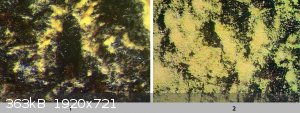
Regarding the preference for the 4-DDNR as energetic material, just a random guess (I know next to nothing about theoretical structural chemistry)
would be that the 4-DDNR maybe behaves more as a zwitter ion due to the para position and more acidic 1-hydroxy group, while for the 2-DDNR the charge
is more delocalized also over the nitrogroups, making that 2-DDNR behaves more readily as an oxidizer? If so, would this still apply to the salts?
[Edited on 17-2-2019 by nitro-genes]
|
|
|
Rosco Bodine
Banned
Posts: 6370
Registered: 29-9-2004
Member Is Offline
Mood: analytical
|
|
The benzene ring is a resonant structure always vibrating and the diazo-oxide across the ring like a bowstring dampens the ring vibrations and
stiffens the molecule so that effective strength of bonds for the hydrogen substituted groups is also increased and the entire molecule is more
stable, less sensitive to decomposition.
When that bowstring breaks, the entire molecule snaps back the opposite direction and flies apart like a suddenly unbalanced gyroscope.
For a possible double salt it would be good to look at Barium Styphnate / Barium DDNR. Mixed solutions of very soluble, probably the Magnesium salts
of Styphnic Acid and DDNR would be added to a stirred solution of Barium Nitrate.
For other possible double salts, instead of Barium Nitrate other metal nitrates could be used, or a mixture of 2 different nitrates could be used for
possible compound salts, such as Potassium Nitrate and Nickel Nitrate. Nitric Acid could be used to adjust the pH of the solution of Nitrate/s and
different temperatures for the reaction could be observed to determine what is useful.
[Edited on 2/17/2019 by Rosco Bodine]
|
|
|
Laboratory of Liptakov
International Hazard
    
Posts: 1334
Registered: 2-9-2014
Location: Technion Haifa
Member Is Offline
Mood: cool.gif
|
|
When I go through this whole thread about DDNP, it seems that DDNP is worse in all parameters than CHP. (TeACP-hexamine clathrate) In production and
explosive parameters. And even in next parameters. Or did I overlook something? Thank you for explaining from anyone..... ....LL ....LL
Development of primarily - secondary substances CHP (2015) Lithex (2022) Brightelite (2023) Nitrocelite (2024)
|
|
|
Rosco Bodine
Banned
Posts: 6370
Registered: 29-9-2004
Member Is Offline
Mood: analytical
|
|
Yeah you overlooked a design criteria for "green" initiators that is they do not contain perchlorate as would cause corrosive residues if used in
firearms.
|
|
|
Laboratory of Liptakov
International Hazard
    
Posts: 1334
Registered: 2-9-2014
Location: Technion Haifa
Member Is Offline
Mood: cool.gif
|
|
Well, for firearms use is DDNP sure better. Thanks for explanation..... ...LL ...LL
Development of primarily - secondary substances CHP (2015) Lithex (2022) Brightelite (2023) Nitrocelite (2024)
|
|
|
Rosco Bodine
Banned
Posts: 6370
Registered: 29-9-2004
Member Is Offline
Mood: analytical
|
|
Quote: Originally posted by nitro-genes  | | Yes, been wondering the same. Similarly to lead azide, the potassium salt of 2-DDNR is described by Kohler to be notorious for its tendency to
detonate when crystallizing from solution. From >5% concentrations of aqueous solutions of the diazoquinone, the potassium salt tends to instantly
crystallize from solution upon introduction of a potassium salt solution, forming a felty network of very fine and long needles (Photo 1) that can
turn the whole liquid into a solid gel-like consistency. It is likely that the described auto-detonation tendency during crystallization originates in
part from this behavior, as is also the case with lead azide. |
A "diazoquinone" huh? How about a resorcinoquinone? 
A massive precipitation of low density fibrous crystals is something that can also occur for picrates and styphnates as an intermediate product that
requires further processing with very specific conditions of dilution and temperature and pH and stirring, to produce a more desirable and compact
crystalline form that is a drastic difference required to provide a useful material. Under certain specific conditions the initial low density
precipitate can form and can then be transformed to the high density material simply by manipulation of the conditions that redissolve the initial
precipitate which may be a higher hydrate, and then recrystallize as a lower hydrate or anhydrous form at a higher temperature and different, usually
lower pH. Sometimes the formation of a double salt will accomplish the dehydration if the double salt forms preferentially to a single salt hydrate.
| Quote: |
The needle crystal morphology can be completely eliminated when a 2% aqueous solution of 2-diazo 4,6-dinitroresorcinol is dripped slowly into a large
excess of an ice-cold potassium acetate/acetic buffer at pH 6, that is completely saturated with KCl or KNO3. As such it forms small, compact and
cubic crystals (Photo 2) that may exhibit better handling properties and may be less likely to self-detonate during its synthesis.
[Edited on 17-2-2019 by nitro-genes] |
And it may be possible also to regulate the mesh size of the crystals and their hydration by changing the temperature and pH and rate of addition and
speed of stirring along with the concentration of the solutions being reacted. Process details can be worked out that produce a constant condition
reaction zone for the solubles that exist in the supernatant solution in which the crystals are suspended to an extent governed by their density and
by the strength of the current in the turbulent liquid. When crystals have grown to a specific size, the crystals settle as heavy sediment in the
stirred liquid. These aspects of "process chemistry" have great bearing on the precise physical properties of a material like a sensitive initiator.
|
|
|
Tsjerk
International Hazard
    
Posts: 3022
Registered: 20-4-2005
Location: Netherlands
Member Is Offline
Mood: Mood
|
|
Quote: Originally posted by Rosco Bodine  |
Speaking of what is and isn't flat on Valentine's Day
[inappropriate image removed j_sum1]
[Edited on 2/14/2019 by Rosco Bodine] |
Keep your eyes on the road man, keep your eyes on the road.
Offering to anyone who can communicate a solid plan for the use of Na2S (to my judgement) in order to make DDNP; I'm willing to ship it to
you when you pay me for the shipping costs. I have quite a lot of it and I don't see any probable need for it in the future.
I don't remember if I have this stuff or the anhydrous stuff which is not listed anymore, but it is clean Na2S.
Edit: I think I have the anhydrous, the only condition is that you report your findings here. When I send you the goods I will of course let you know
whether or not it is the nona or the anhydrous.
Edit2: I will note your name here when I send you the goods.
[Edited on 21-2-2019 by Tsjerk]
[Edited on 23-2-2019 by j_sum1]
|
|
|
nitro-genes
International Hazard
    
Posts: 1048
Registered: 5-4-2005
Member Is Offline
|
|
@ Rosco....Yeah, I get the feeling there may be some hydrates involved here and there after all. I wont be continuing with the salt of 2-DDNR though,
think it is time to quit with eyes, ears and fingers still working and attached.
"A "diazoquinone" huh? How about a resorcinoquinone?  " I don't get it, What do
you mean by that? " I don't get it, What do
you mean by that?
Recrystallized some of the last completely dry 2-DDNR from acetone solubility in boiling acetone is about 1 g 2-DDNR /33.5 ml acetone....seems to work
fine.
[Edited on 22-2-2019 by nitro-genes]
Attachment: 2-diazo 4,6-dinitroresorcinol recrystallized acetone.avi (769kB)
This file has been downloaded 858 times
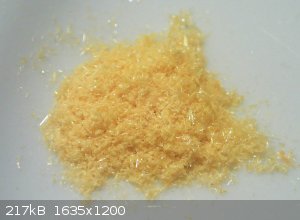
|
|
|
nitro-genes
International Hazard
    
Posts: 1048
Registered: 5-4-2005
Member Is Offline
|
|
Curiosity won again... Ok, one final experiment with the potassium salt! 
The brown compact crystals of the potassium salt of 2-diazo 4,6-dinitroresorcinol as obtained from 2% aqueous solutions of the 2-DDNR (as in my
writeup in prebub) present somewhat of a mystery it seems. I performed the exact same precipitation reaction again, the only difference only being
that instead of the crude 2-DDNR, the acetone recyrstallized product was used. The KNO3 saturated potassium acetate/acetic buffer was exactly the
same, as I made a large batch to make some comparisons and had quite some left. From a 2% aqueous solution of the acetone recrystallized 2-DDNR, there
was still a lot of the the fibrous needle morphology material present. Only when the 2-DDNR solution was diluted further to about a 0.2% aqueous
solution, the potassium salt precipitated as the small more compact crystals, only the colour was not a brownish, though a light yellow. Even from the
0.2% solution, some sporadic needles were present when looked under the binoc. With very high stirring rates (probably very dangerous) and very slow
addition, the compact crystals can be also formed from a 2% aqueous solution of the pure 2-DDNR.
So:
It seems very unlikely the brown material is a hydrate, as Benedikt an Hubl suggest. To see if this is a double salt with some impurity instead (maybe
dinitropyrogallol or some quinone/product derived from it?) one would have to do some large scale yield measurements on the crude 2-DDNR or
qualitative tests on the brown material, so out of my reach. I must say, I don't think there is enough of any impurity present to form a double salt
or explain the difference in crystal morphology by the lower true concentration of 2-DDNR in the crude product. The most likely explanation seems
that some impurity is present in the crude 2-DDNR isolated directly from the diazotization that acts as a powerful crystal modifier and allows the
compact crystal shape for the potassium salt to form from aqueous solutions of the 2-DDNR at a >10 fold higher concentration and minimal stirring
as compared to the (presumably) more pure compound from acetone.
I've been wondering if some of these crystal modifiers act purely as by retarding the onset of first crystallization. Maybe dextrin would be
effective for the pure compound...
[Edited on 23-2-2019 by nitro-genes]
|
|
|
Laboratory of Liptakov
International Hazard
    
Posts: 1334
Registered: 2-9-2014
Location: Technion Haifa
Member Is Offline
Mood: cool.gif
|
|
In this thread, I feel like a student who listens to the debate of several university professors of chemistry..... ...LL ...LL
Development of primarily - secondary substances CHP (2015) Lithex (2022) Brightelite (2023) Nitrocelite (2024)
|
|
|
Rosco Bodine
Banned
Posts: 6370
Registered: 29-9-2004
Member Is Offline
Mood: analytical
|
|
Quote: Originally posted by nitro-genes  | | @ Rosco....Yeah, I get the feeling there may be some hydrates involved here and there after all. I wont be continuing with the salt of 2-DDNR though,
think it is time to quit with eyes, ears and fingers still working and attached. |
Silver fulminate can be a sensitive beast too but there have been procedures worked out for risk management regarding that material.
| Quote: |
"A "diazoquinone" huh? How about a resorcinoquinone?  " I don't get it, What do
you mean by that? " I don't get it, What do
you mean by that? |
Standard nomenclature generally names a quinone with the prefix for the parent aromatic, like anthraquinone for anthracine, benzoquinone for benzene,
therefore resorcinoquinone for resorcinol. See?
| Quote: |
Recrystallized some of the last completely dry 2-DDNR from acetone solubility in boiling acetone is about 1 g 2-DDNR /33.5 ml acetone....seems to work
fine.
[Edited on 22-2-2019 by nitro-genes] |
It is unknown what the copper salt of DDNR might have as properties, but if it is low solubility it could form as less sensitive colloidal size
particles. Maybe prepare a solution of a soluble copper salt and run into it a soluble salt of DDNR and see what you get as a product.
|
|
|
nitro-genes
International Hazard
    
Posts: 1048
Registered: 5-4-2005
Member Is Offline
|
|
Final report on styphnamic and its diazoderivative...there, I'm all done! 
|
|
|
nitro-genes
International Hazard
    
Posts: 1048
Registered: 5-4-2005
Member Is Offline
|
|
There, I'm all done! 
Attachment: Synthesis and some properties of 2-amino 4,6-dinitroresorcinol and 2-diazo 4,6-dinitroresorcinol.pdf (4.1MB)
This file has been downloaded 1163 times
[Edited on 28-2-2019 by nitro-genes]
|
|
|
Rosco Bodine
Banned
Posts: 6370
Registered: 29-9-2004
Member Is Offline
Mood: analytical
|
|
Done huh? Hope springs eternal  You aren't getting off that easy. You aren't getting off that easy. 
Page numbering ? Anyway on what would be numbered as page 5 if you beat me into submission proofreading and editing  just above the pictures you wrote: just above the pictures you wrote:
"Either 2-diazo 4,6-dinitroresorcinol itself or its salts have been tested for use in detonators and priming compositions, though were claimed to be
incompatible with certain base charges [20,21]."
Who claimed? Federoff ???? Ha! Federoff even fell prey to the classic nitrite-nitrate alternate universe error !  Take the Federoff Take the Federoff
summary blurb with a HUGE grain of NaCl !! Caveat emptor
The Federoff article is IIRC incorrect and references the Von Herz British patent along with a Chemical Abstract summary I don't recall ever having
seen......So this is possibly not correct but is another Federoff typo. The structure of DDNR is also incorrectly identified by Federoff. These
compounds were generally called
"quinone diazides" (incorrect) or "diazo-anhydrides" after the cyclic nature was identified for the diazo-oxy linkage displacing a phenolic hydrogen.
In my understanding what I would call this general class of compounds is:
diazo-nitrophenol-anhydrides or probably better
nitrophenol-diazo-anhydrides
Anyway it seems clearly an editing oversight in Federoff referencing a patent and "claims" that do not reconcile with what Federoff shows as
"unstable" should read instead as "usable" or "useful" as *is* what the patent claims clearly state along with the measured weights of initiator found
"useful" with several commonly used base charges.
Obviously it would be silly for a reputable chemist Von Herz to patent and make "claims" to publish at great expense the discovery of useless and
unstable compounds in order to attest to their lack of value.  More likely
Federoff transcribers and editors simply screwed the pooch and left the pooch screwed for posterity. More likely
Federoff transcribers and editors simply screwed the pooch and left the pooch screwed for posterity.
Who was Von Herz anyway ??? Obscure chemist hardly ...IIRC
Von Herz invented cyclonite or RDX ....but somebody should probably check me on that since I am getting old and confused, probably the senility
creeping up on me  IIRC it was also Von Herz first filed for patent on the use of
DDNP as an initiator. IIRC it was also Von Herz first filed for patent on the use of
DDNP as an initiator.
A reference needed is the Chemical Abstracts (1924) Volume 18, page 1574 which may reference a journal article by Von Herz that a general search may
find also, unless the abstract simply announces the British patent which is very likely.
Is there anything in the patent that is specific to instability or other issue related to "certain base charges"?
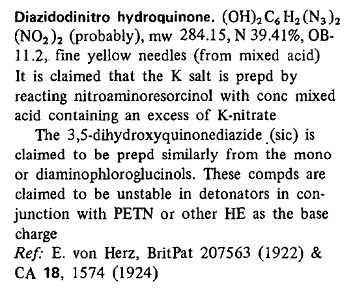
Here is an interesting compound where hexamethylene tetramine is shown to bridge complex 2 copper compounds, and such a scheme might work for copper
DDNR similarly as it does for copper azide and may be useful as a desensitizer integrated on a molecular level. Other metal salts might also be
susceptible.
For the complex if it would form with copper DDNR, there would be 4 of the mono-acid DDNR molecules in a compound having 2 copper atoms bridged by
hexamethylene tetramine. If the hypothetical compound forms, it may be possible to use the benign ammonium DDNR as a precursor. Whether the speculated
compound will form at all or whether any troublesome hydrate may be an issue is completely unknown, since the hypothetical compound is unreported and
may be novel.
Glycine should similarly bridge complex 2 copper molecules, and may work better for the same purpose.
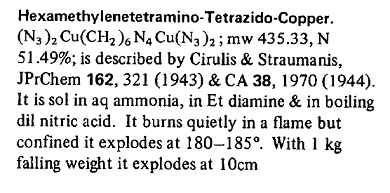
Edmund von Herz (from Vienna Austria) also invented Lead Styphnate primers
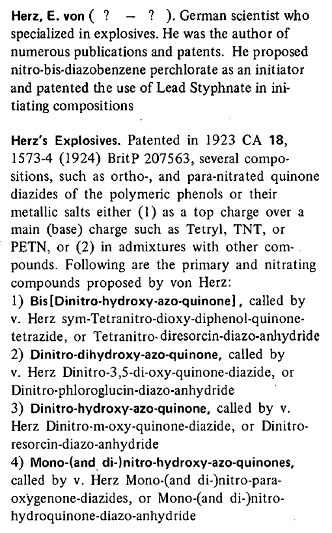
[Edited on 3/1/2019 by Rosco Bodine]
|
|
|
Laboratory of Liptakov
International Hazard
    
Posts: 1334
Registered: 2-9-2014
Location: Technion Haifa
Member Is Offline
Mood: cool.gif
|
|
Hexamethylenetetramine (hexamine) and CuO and NH3 gas, I consider for the best substances for synthesis most powerful energy salts. After adding
some suitable salt, in suitable solvent, always arises some, what has energetic properties. Is it an Holy triad.... ...LL ...LL
Development of primarily - secondary substances CHP (2015) Lithex (2022) Brightelite (2023) Nitrocelite (2024)
|
|
|
MineMan
National Hazard
   
Posts: 998
Registered: 29-3-2015
Member Is Online
Mood: No Mood
|
|
Tell us more LL. Are these dissolved in ammonia then more gas is bubbles through.
What kind of EM, primary, secondary?
|
|
|
Laboratory of Liptakov
International Hazard
    
Posts: 1334
Registered: 2-9-2014
Location: Technion Haifa
Member Is Offline
Mood: cool.gif
|
|
Glycine
Was confirmed (repeatedly) very easy D2D effect with TACP 86% + 14% glycine. ( OB glycine - 95,87, TACP + 14,5) Brizance is worse than CHP, but only
slightly. Estimation is 10% down. Crystalls are more blue light, more monochromatic, similarly as wet TACP. Someones researchers has not available
hexamine, but glycine yes. Among other things, glycine is a universal medicine for almost everything. If you get tired of banging, you can eat 1-2 g
per day of glycine. Next interest thing: Glycine react with CuO in hot water 90 C immediately on copper glycinate (??) , which crystallized at 10 C
(or less) from mother liquer. Also almost immediately. Copper-glycinate (??) not react with NaClO4 or NH4ClO4. Therefore is impossible create
copper-glycine-perchlorate. It require HClO4 or else described procedure. On picture is tetraamine copper glycine perchlorate, as mixture. No copper
glycine perchlorate as molecule crystals.... ...LL ...LL
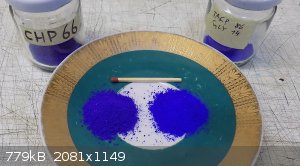
Development of primarily - secondary substances CHP (2015) Lithex (2022) Brightelite (2023) Nitrocelite (2024)
|
|
|
MineMan
National Hazard
   
Posts: 998
Registered: 29-3-2015
Member Is Online
Mood: No Mood
|
|
Very fascinating! Great find LL...!!!
Don’t the TACP crystals dehydrate, even in a detonator...? Or is this a viable replacement for CHP? What do you mean you can take one if your tired
of banging?
|
|
|
Laboratory of Liptakov
International Hazard
    
Posts: 1334
Registered: 2-9-2014
Location: Technion Haifa
Member Is Offline
Mood: cool.gif
|
|
Is it viable replacement for CHP. TACP, CHP and CGP (Tetraamine copper glycine perchlorate) are non-hygroscopic. The tired from banging was an joke
only. Of course, in detonator are all 3 compounds and his mixtures stabille, even with residual wet 1% estimated in cavity. TACP in mixture with
Aluminium powder or nitrocellulose, or else unknown fuel, can be unstable.
Development of primarily - secondary substances CHP (2015) Lithex (2022) Brightelite (2023) Nitrocelite (2024)
|
|
|
| Pages:
1
..
29
30
31
32
33 |